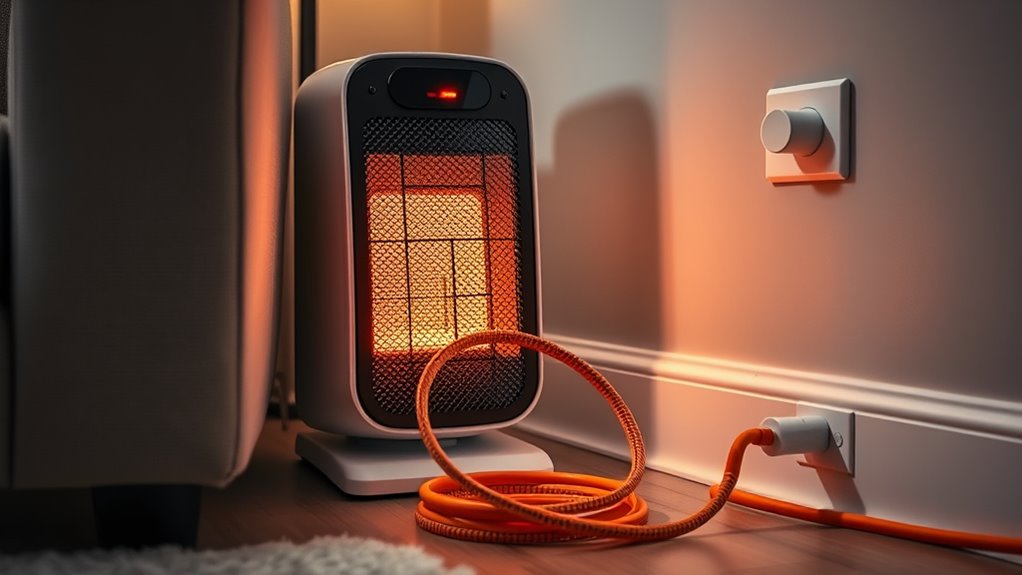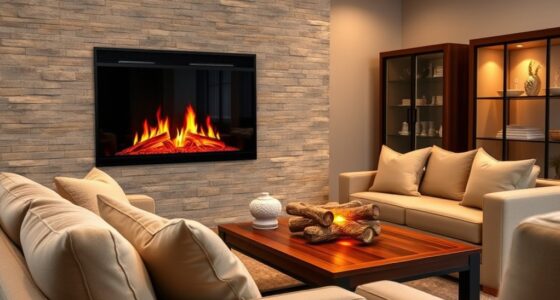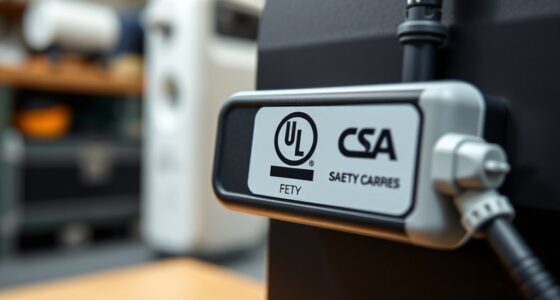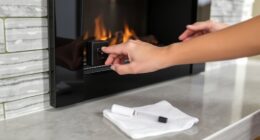To keep your space safe when using extension cords with heaters, always choose the right cord rated for your heater’s wattage and avoid overloading outlets. Make sure cords are in good condition, fully uncoiled, and properly positioned away from traffic and furniture. Never daisy-chain multiple cords or use damaged ones. Proper placement and routine inspections are key. Keep in mind, following these safety tips can prevent fires—continue to learn more about safe heater and cord use.
Key Takeaways
- Use cords rated for the heater’s wattage and appropriate length to prevent overheating and voltage drops.
- Fully uncoil extension cords and avoid daisy-chaining to reduce heat buildup and fire risk.
- Regularly inspect cords and plugs for damage; replace immediately if wear or fraying is found.
- Keep cords away from high-traffic areas, rugs, and furniture to prevent tripping and overheating.
- Opt for permanent wiring when grounding or continuous power supply is needed for safety and reliability.
Choosing the Right Extension Cord for Your Heater
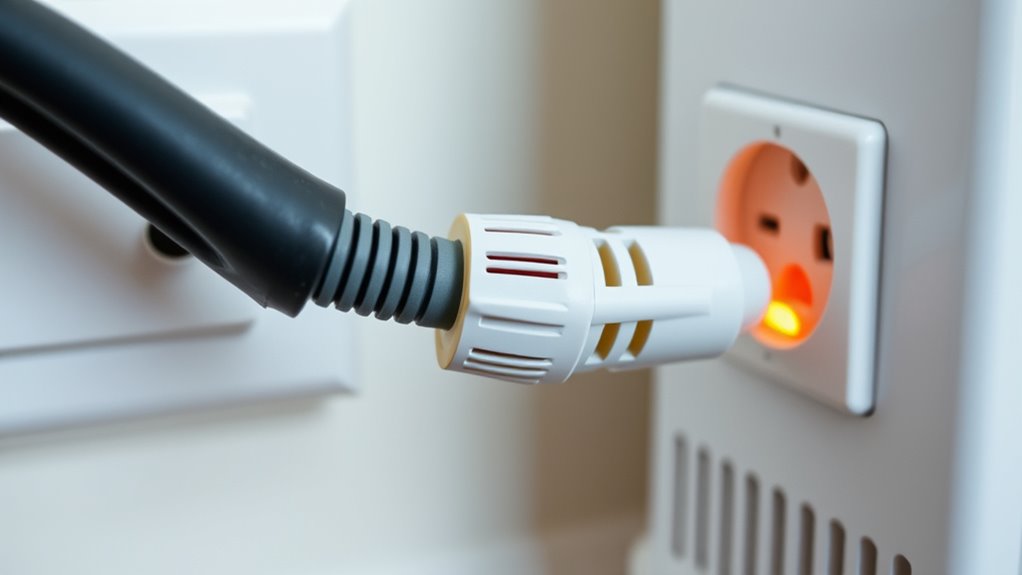
Choosing the right extension cord for your heater is vital to guarantee safety and proper operation. You need to take into account cord length considerations; a cord that’s too long can cause voltage drops, reducing heating efficiency and increasing fire risk. Ideally, use the shortest cord possible to power your heater effectively. Additionally, understand the difference between indoor versus outdoor cords. Indoor cords are designed for dry, controlled environments and typically lack weatherproofing, while outdoor cords are built to withstand moisture, temperature changes, and rough handling. Using an outdoor cord indoors can be unsafe, and vice versa. Always select a cord rated for your heater’s power needs, and avoid overextending with a cord that’s too long or inappropriate for your environment. Proper choice ensures safe, reliable operation. When selecting an extension cord, consider proper maintenance to prevent wear and damage that could compromise safety.
Understanding Power Ratings and Compatibility
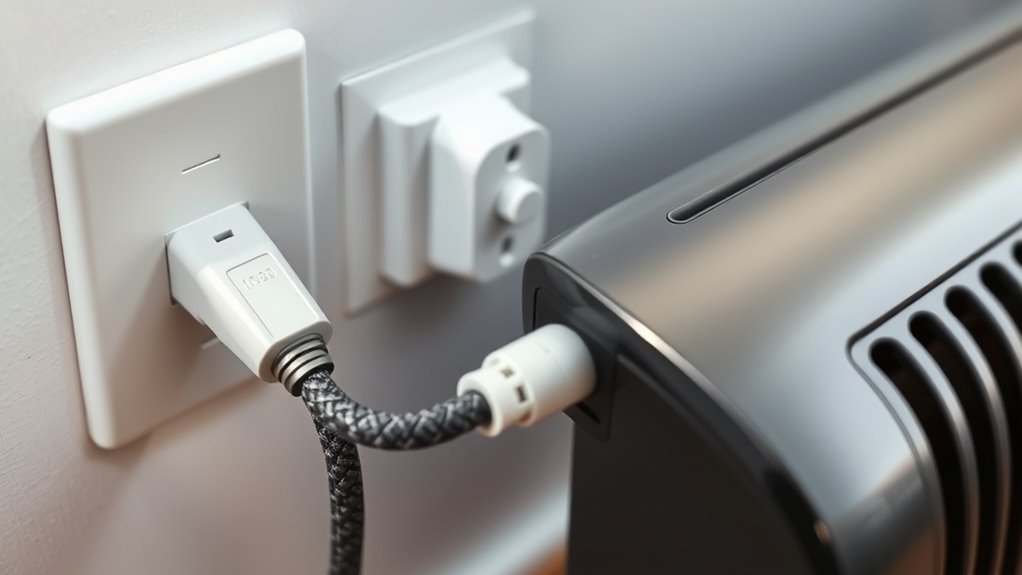
You need to understand the power ratings of your heater and extension cords to avoid overloads. Checking compatibility guarantees the cord can handle the wattage safely and efficiently. Ignoring these ratings can lead to overheating or electrical hazards. Additionally, understanding safety guidelines ensures proper usage and minimizes risks during outdoor or indoor camping setups.
Power Ratings Explained
Understanding power ratings is essential for ensuring your extension cord can safely handle your heater’s energy needs. Power ratings, usually expressed in watts or amps, indicate the maximum load a cord can handle without overheating or failing. When choosing a cord, consider the cord material, as thicker, high-quality copper wires conduct electricity more efficiently and safely. Insulation quality also matters because good insulation prevents heat buildup and protects against electrical shorts. Always match the extension cord’s rated capacity with your heater’s power requirements. Using a cord with a lower rating can cause overheating, while an overly high-rated cord offers unnecessary bulk but doesn’t harm safety. Pay close attention to these ratings to keep your setup safe and reliable. Additionally, proper ventilation helps dissipate heat and reduces the risk of overheating during prolonged use.
Compatibility Checks Essential
Ensuring your extension cord is compatible with your heater is essential for safe operation. You need to take into account cord length considerations to prevent voltage drops that can cause overheating or reduced performance. A longer cord may seem convenient, but it can lead to increased resistance, so choose the shortest suitable cord for your setup. Always match the cord’s power rating with your heater’s requirements; using an undersized cord risks overheating and fire hazards. Additionally, proper cord storage tips help maintain safety—avoid tightly winding cords, which can cause damage and heat buildup. Regularly inspect your extension cord for signs of wear or damage, and replace it if necessary. Also, be aware of the power ratings to ensure your extension cord can handle the load safely, preventing potential hazards. Compatibility checks are a simple but fundamental step to ensure your heater operates safely and efficiently.
Recognizing the Risks of Overloading Cords

Overloading extension cords can considerably increase the risk of electrical fires or damage. When too many devices draw power from a single cord, it causes a circuit overload, putting stress on the cord insulation. Over time, this stress weakens the insulation, increasing the chance of short circuits or sparks. You might notice the cord feels hot or looks damaged, which signals danger. Using a cord beyond its capacity can also cause the circuit breaker to trip or, worse, ignite a fire. To stay safe, always check the cord’s label for maximum load capacity, avoid plugging multiple high-wattage devices into one cord, and regularly inspect for signs of wear. Recognizing these risks helps prevent accidents and keeps your space safe. Incorporating automation in business intelligence can also help monitor electrical systems and alert you to overloads before they become hazardous.
Proper Placement and Usage of Extension Cords With Heaters
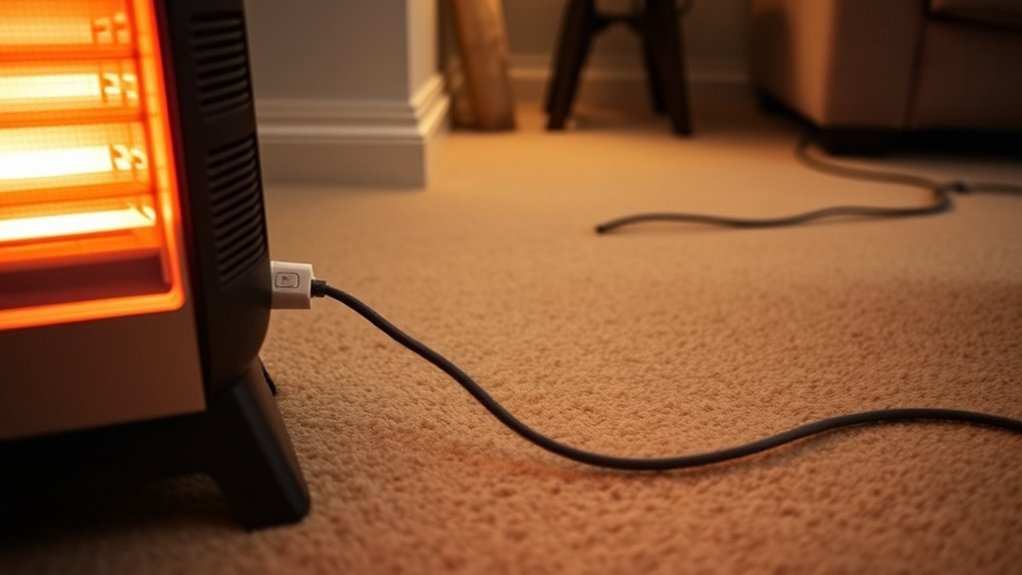
To safely use extension cords with heaters, you need to pay close attention to their placement and how you connect your devices. Proper cord management helps prevent tripping hazards and accidental damage. Always choose the right extension cord type for your heater—heavy-duty cords with thick gauges are best for high-wattage appliances. Keep cords away from high-traffic areas and avoid running them under rugs or furniture, which can cause overheating. Ensure cords are fully uncoiled to prevent heat buildup and damage. Position cords so they don’t pinch or strain connections, and avoid daisy-chaining multiple extension cords together. Using cords with appropriate power ratings is also essential to handle the horsepower of electric dirt bikes and other high-power devices safely. By managing cords carefully and selecting the appropriate extension cord type, you reduce fire risks and ensure your heater operates safely and efficiently.
Inspecting Cords and Plugs for Damage

Regularly inspecting your extension cords and plugs is key to maintaining safe heater use. Check the cord insulation for any cuts, cracks, or fraying that could expose wires and increase the risk of electrical shock or fire. Ensure the plug prongs are intact, straight, and free of corrosion or burn marks, which can hinder proper connection. Damaged insulation can lead to electrical shorts, while bent or corroded prongs may cause poor contact or sparks. If you notice any signs of damage, stop using the cord immediately. Replacing damaged cords or plugs is essential to prevent hazards. Always handle cords carefully during inspection, and avoid forcing plugs into outlets if they don’t fit properly. Staying vigilant keeps you and your home safe. Additionally, understanding electrical safety principles can help you identify potential hazards early and prevent accidents.
Safe Connection Practices to Prevent Fires and Shorts
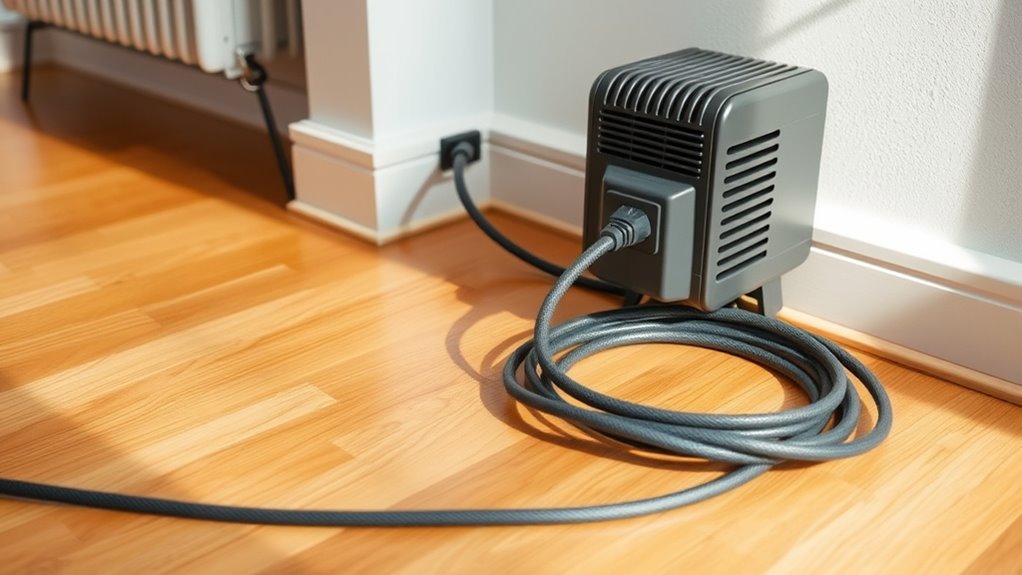
To prevent fires and shorts, make sure you’re using extension cords with the proper gauge for your heater’s power needs. Never overload outlets by plugging in too many devices, as this increases the risk of overheating. Always connect your heater directly or with cords rated for high wattage to keep things safe.
Use Proper Gauge Cords
Using the correct gauge extension cord is essential for safe heater operation. Choosing the right gauge depends on your heater’s power needs and the cord length. A thicker gauge (lower number) handles more current without overheating, reducing fire risk. Shorter cords can often handle a higher gauge, while longer cords require a thicker gauge to prevent voltage drops and overheating. Additionally, always check for safety certifications to ensure the cord meets safety standards.
| Cord Length | Recommended Gauge |
|---|---|
| Up to 25 ft | 16 or 14 AWG |
| 25-50 ft | 12 or 14 AWG |
| Over 50 ft | 10 or 12 AWG |
| Very long | Consult electrician |
Select the appropriate gauge to ensure safe, reliable operation, avoiding shorts and overheating.
Avoid Overloading Outlets
Overloading electrical outlets can cause overheating and increase the risk of fires or electrical shorts. To prevent this, practice proper cord management by distributing your devices across multiple outlets instead of plugging too many into one. Avoid daisy-chaining extension cords or power strips, as this overloads the circuit. Pay attention to outlet placement; choose outlets that are easily accessible and not already crowded with other cords or devices. Keep cords organized and untangled to reduce strain on the connections. Never force multiple high-wattage devices, like heaters, into a single outlet or power strip. By managing your cords carefully and spreading out your electrical load, you reduce the risk of overheating, shorts, and potential fire hazards. Proper use of power strips and understanding of electrical safety can further help prevent overloads.
Avoiding Common Mistakes and Unsafe Habits
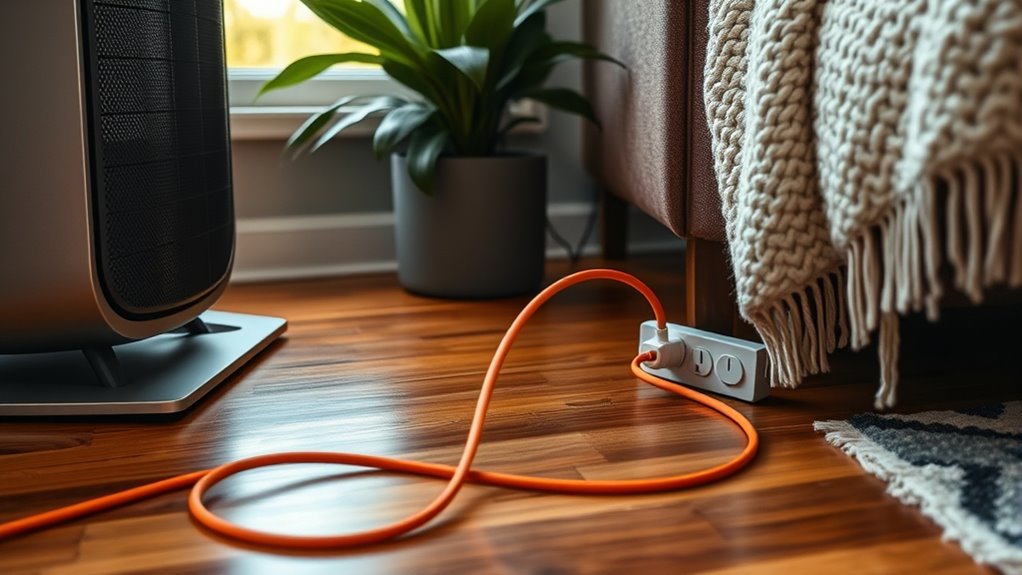
Many accidents happen because people make simple mistakes or develop unsafe habits when using extension cords with heaters. One common mistake is leaving cords exposed or tangled, which can lead to damage or tripping hazards. Avoid cord theft by never leaving extension cords unattended in unsecured areas, especially outdoors. Proper extension cord storage is essential—roll up cords neatly and store them in a safe, dry place when not in use to prevent wear and tear. Additionally, don’t run cords under rugs or furniture, as this can cause overheating or damage. Always check cords regularly for frays or damage, and replace damaged ones immediately. Developing these safe habits helps prevent accidents and ensures your heating setup stays secure and functional. Embracing safety precautions is key to enjoying your heater without risks.
Tips for Maintaining a Safe Heating Environment
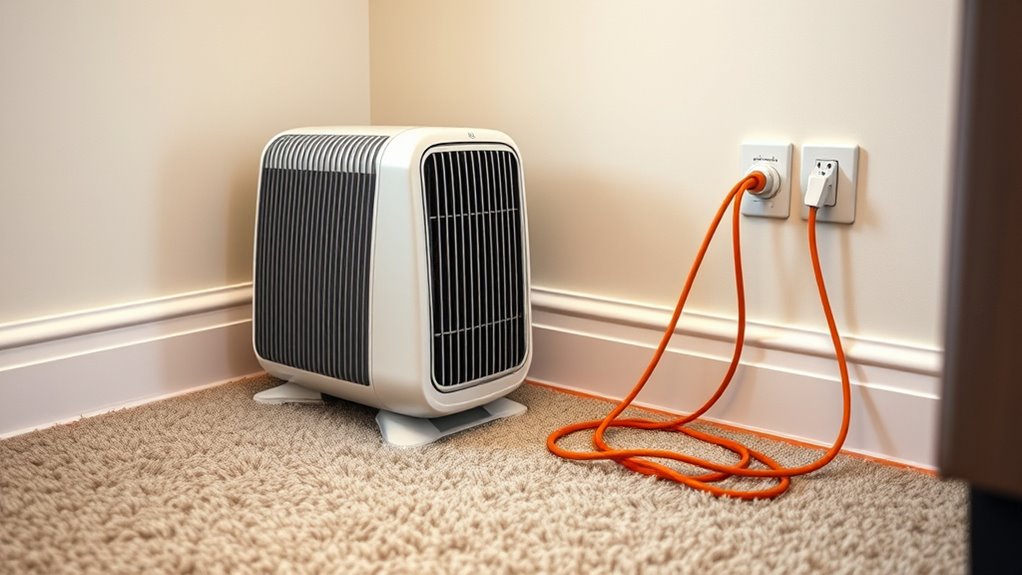
Maintaining a safe heating environment involves proactive steps to guarantee your space stays secure and efficient. Prioritize indoor safety by regularly inspecting your heaters and extension cords for damage or wear. Keep combustibles away from heat sources to reduce fire risk and ensure proper ventilation to prevent carbon monoxide buildup. Use only approved extension cords designed for indoor safety and heaters, avoiding overloading outlets. Turn off heaters when unattended or sleeping, and never block vents or air intakes. Keep cords organized to prevent tripping hazards and accidental damage. Regular maintenance, like cleaning filters and checking wiring, helps prevent malfunctions that could lead to fires. By staying vigilant and following these tips, you considerably reduce fire prevention risks and create a safer indoor environment.
When to Use Permanent Wiring Solutions Instead of Extension Cords
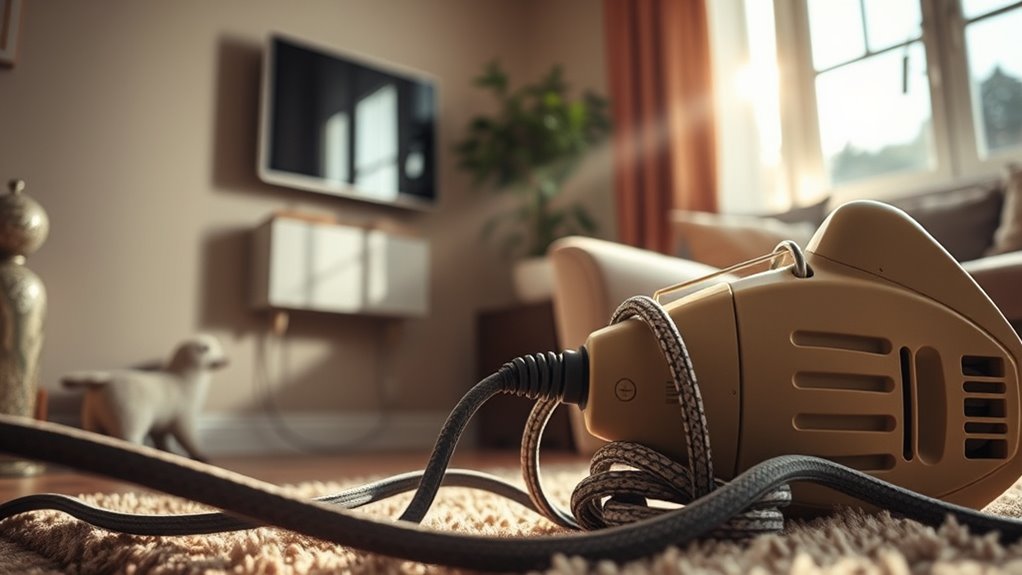
Using extension cords for permanent wiring is generally unsafe and should be avoided whenever possible. If you need a reliable, long-term power solution, consider permanent wiring instead. You should opt for this when:
- Grounding requirements are essential for safety, especially with heaters that draw high current.
- Cord length considerations make extension cords impractical or potentially hazardous, such as when cords are stretched across walkways.
- You require consistent power without the risk of overheating or damage caused by repeated plugging and unplugging.
Permanent wiring ensures proper grounding, reduces the risk of electrical faults, and complies with safety standards. It provides a secure, long-lasting solution that minimizes hazards associated with extension cord use in heating applications.
Frequently Asked Questions
Can Using an Extension Cord Void My Heater’s Warranty?
Using an extension cord can nullify your heater’s warranty if it doesn’t meet the manufacturer’s heater warranty conditions. Many warranties specify proper extension cord maintenance and recommend using only approved cords to guarantee safety and performance. If you use an incompatible or damaged extension cord, it could be considered misuse, leading to a warranty void. Always check your heater’s warranty conditions before plugging in with an extension cord.
What Are the Signs of an Unsafe Extension Cord?
You’ll know an extension cord is unsafe if you see visible damage like fraying, cuts, or exposed wires. Over time, extension cord damage may lead to overheating hazards, increasing the risk of fires or electrical failures. Avoid using cords with any signs of damage, as they can’t handle the current safely. Always inspect your extension cords regularly and replace any that show signs of wear to keep your heater and home safe.
Are There Specific Extension Cord Certifications I Should Look For?
Yes, you should look for extension cord certifications like UL, ETL, or CSA, which guarantee the cord meets safety standards. These certifications help protect your heater’s warranty by reducing fire and electrical hazards. Using certified extension cords keeps your heating device safe and preserves its warranty coverage. Always choose cords with proper certifications to ensure safe operation and avoid potential damage or risk.
How Often Should I Replace Damaged Extension Cords?
You should replace damaged extension cords immediately to guarantee safety. Regularly inspect your cords for fraying, cuts, or exposed wires, as these signs indicate a shortened extension cord lifespan and increased risk of damage. Don’t delay in replacing cords showing any damage—prevention is key to avoiding electrical hazards. Prioritize damage prevention by replacing cords at the first sign of wear, keeping your space safe and your heater functioning reliably.
Can Outdoor Extension Cords Be Safely Used Indoors With Heaters?
Outdoor extension cords shouldn’t be used indoors with heaters because they lack indoor safety features and may not support the necessary power capacity. Using them can increase the risk of electrical hazards. For safe indoor heater operation, choose a cord rated for indoor use and appropriate power levels. Always check the cord’s specifications to make sure it can handle the heater’s power demands, preventing overheating or fire risks.
Conclusion
So, next time you’re tempted to toss that extension cord like a snack into a bowl, remember: your heater’s safety isn’t a game. Overloading, damage, or careless placement could turn your cozy space into a fiery disaster. Think you’re too busy to check cords? Well, maybe your house isn’t the best place for a DIY fireworks show. Play it safe, stay smart, and keep your home warm without turning it into a cautionary tale.
